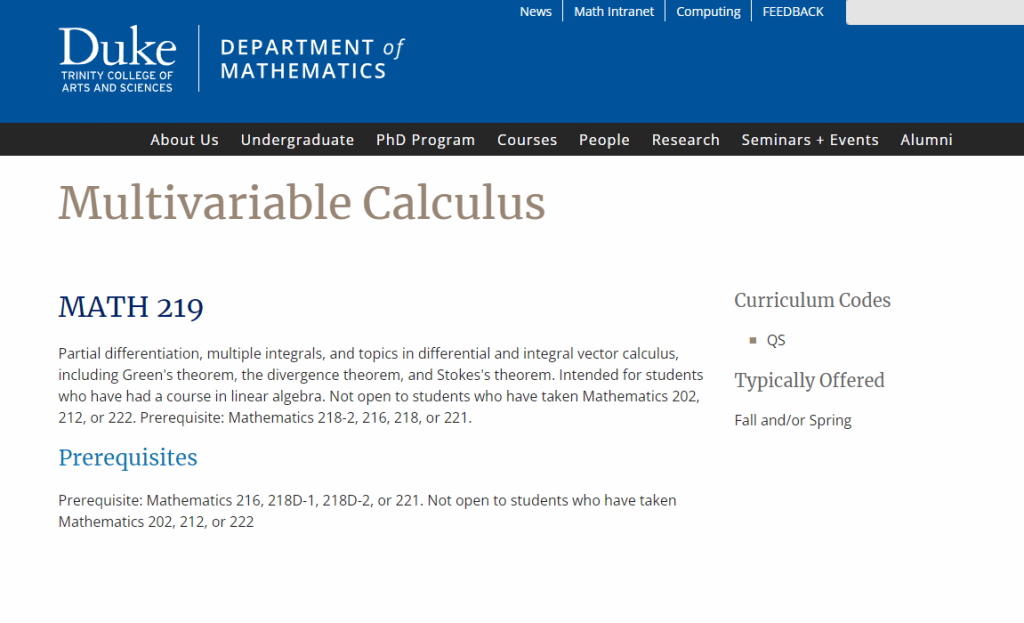Assignment-daixieTM为您提供杜克大学Duke UniversityMATH 219 Multivariable Calculus多变量微积分代写代考和辅导服务!
Instructions:
In the calculus of more than two variables, it is necessary to introduce partial derivatives and multiple integrals, which are generalizations of their analogs in elementary calculus. For some problems, coordinate systems other than Cartesian are more advantageous, the most frequently used being cylindrical and spherical coordinates. Line integrals are a new feature of multivariable calculus. Green’s theorem provides an important connection between line integrals and surface integrals.

Where does the line through the points (−3, 1, 0) and (−1, 5, 6) intersect the plane 2x + y − z + 2 = 0?
First we find the direction vector of the line: $\mathbf{v}=\langle-1,5,6\rangle-\langle-3,1,0\rangle=\langle 2,4,6\rangle$. Therefore the line through the given points can be written as
$$
\mathbf{r}(t)=\langle-3,1,0\rangle+t\langle 2,4,6\rangle,
$$
or yet $x(t)=-3+2 t, y(t)=1+4 t, z(t)=6 t$. Plugging these equations into the equation of the plane,
$$
2(-3+2 t)+(1+4 t)-6 t+2=0
$$
gives $t=3 / 2$, thus $(0,7,9)$
(a) Let $F$ be a differentiable function of two variables $x$ and $y$, and suppose that $F(x, y)=5$ defines $y$ implicitly as a differentiable function of $x$. Show that
$$
\frac{\partial F}{\partial x}+\frac{\partial F}{\partial y} \frac{d y}{d x}=0
$$
(b) State the implicit function theorem. Explain, in words, why it is true. (Hint: use pictures to illustrate your argument.)
Solution 4. For (a), write $y=y(x)$ so that $F(x, y)=F(x, y(x))$ and apply the chain rule:
$$
\frac{d}{d x} F(x, y(x))=\frac{\partial F}{\partial x}(x, y(x)) \frac{d x}{d x}+\frac{\partial F}{\partial y}(x, y(x)) \frac{d y}{d x}=\frac{d}{d x} 5=0,
$$
which gives the result since $\frac{d x}{d x}=1$.
(b) Implicit function theorem: If $F=F(x, y)$ is defined in a neighborhood of $\left(x_0, y_0\right), F\left(x_0, y_0\right)=$ $0, F_x$ and $F_y$ exist and are continuous, and $F_y\left(x_0, y_0\right) \neq 0$, then $F(x, y)=0$ defines $y$ as a function of $x$ in a neighborhood of $\left(x_0, y_0\right)$.
The basic intuition is the following. If $F_y\left(x_0, y_0\right) \neq 0$, then the tangent line to the curve $F(x, y)=$ 0 at $\left(x_0, y_0\right)$ is not parallel to the $y$-axis. Since this tangent line approximates the curve near $\left(x_0, y_0\right)$, there does not exist a vertical line that intersects that curve $F(x, y)=0$ twice in a small neighborhood of $\left(x_0, y_0\right)$. Hence, for each point $(x, y)$ on the curve (and near $\left.\left(x_0, y_0\right)\right)$ there corresponds a unique $y$, which means that $y$ can be viewed as a function of $x$ along $F(x, y)=0$ and near $\left(x_0, y_0\right)$.
Consider the function
$$
f(x, y)=4 x y^2-x^2 y^2-x y^3 .
$$
Let $D$ be the closed triangular region in the $x y$-plane with vertices $(0,0),(0,6)$, and $(6,0)$.
(a) Explain why $f$ has an absolute maximum value and an absolute minimum value in $D$.
(b) Find the absolute maximum value and the absolute minimum value of $f$ in $D$.
(a) $f$ is a continuous function and $D$ is a closed bounded set. Hence $f$ attains an absolute maximum and absolute minimum in $D$ by the extreme value theorem.
(b) Compute $f_x(x, y)=4 y^2-2 x y^2-y^3=0$. This gives $y=0$ or $y=4-2 x$. Since $y=0$ belong to the boundary of $D$, which will be analyzed separately below, we can ignore it for now. Next, find $f_y(x, y)=8 x y-2 x^2 y-3 x y^2$. Setting this expression equal to zero and plugging in $y=4-2 x$ we find
$$
8 x(4-2 x)-2 x^2(4-2 x)-3 x(4-2 x)^2=x(4-2 x)(4 x-4)=0
$$
which gives $x=0, x=1$, or $x=2$. As before, $x=0$ is on the boundary of $D$ so we can ignore it for now. When $x=2$, we have $y=4-2 x=0$ which can also be ignored at this point since $y$ then belongs to the boundary of $D$. Hence, we are left with $x=1$, so $y=2$, and this gives $f(1,2)=4$.
Now we analyze the behavior of $f$ on the boundary of $D$. The boundary is given by three lines:
$$
L_1:{x=0,0 \leq x \leq 6}, L_2:{(x, y) \mid y=-x+6,0 \leq x \leq 6}, L_3:{y=0,0 \leq y \leq 6}
$$
Along $L_1$ and $L_3$ we have $f(x, 0)=0$ and $f(0, y)=0$, respectively. Along $L_2$,
$$
g(x)=f(x, 6-x)=-2\left(x^3-12 x^2+36 x\right)
$$
We seek that absolute maximum and minimum of $g$ on $[0,6]$. Computing $g^{\prime}(x)=-6(x-2)(x-6)=$ 0 we find $x=2$ and $x=6$. For $x=2$ we have $y=4$ and $f(2,4)=-64 . x=6$ is an endpoint, and the endpoints $x=0$ and $x=6$ have already been tested in $L_3$ and $L_1$, respectively.
We conclude that the absolute maximum is 4 , occurring at $(1,2)$, and the absolute minimum is $-64$, occurring at $(2,4)$
